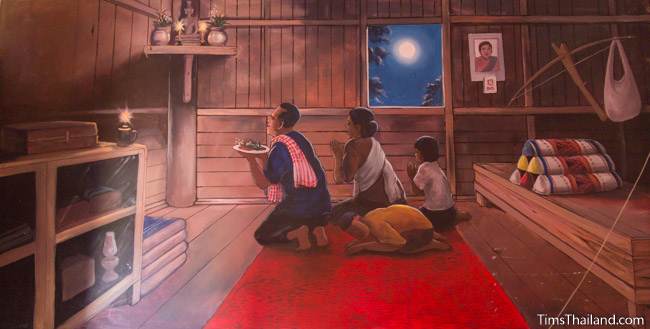อ่านภาษาไทยที่นี่ (Click here to read a Thai version.)
This is the second of two pages explaining the ground-floor murals inside Wat Nong Wang‘s Phra Mahathat Kaen Nakhon stupa. These murals are all about Isan culture. Murals #1-23, about Khon Kaen history and the general introduction about the murals are on the first page.
— — —
Northeastern Way of Life
(24) Land of the Kaen.
Khon Kaen is known to some as the land of the kaen (No relation to the word Kaen in the city’s name; in Thai, the spellings and pronunciations are different.), a musical instrument made of bamboo played with two hands. The kaen has a beautiful, exciting sound and is played at nearly all Isan festivals. In the past, just before sunset, elders would play a kaen to call children from the village together to learn about morals, culture, history, etc. The sound of the kaen made these meetings fun for the kids.
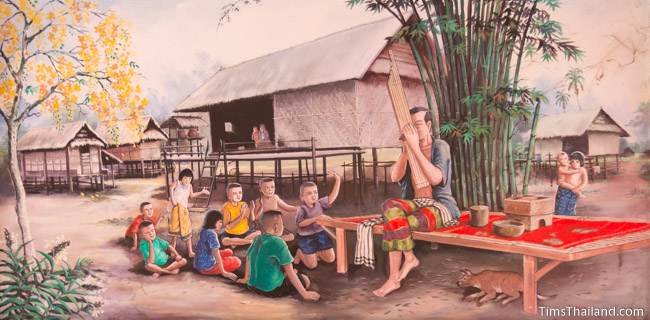
(25) Long Kuang and Long Khaek.
It used to be common for people to Long Kuang (“come down to the village gathering place”) at night. People would do work, such as spinning thread, while socializing and eating. There might also be music, dancing, and poetry. For young people it was an important time for courtship. Bonfires were made of bamboo because when burned it makes a brighter light than firewood. While Long Kuang is now very rare, Long Khaek is still a common community tradition. Long Khaek is when people come together to help their neighbors and relatives with work, such as building a home, harvesting rice, or dying silk threads. Both traditions keep people generous and villages united.
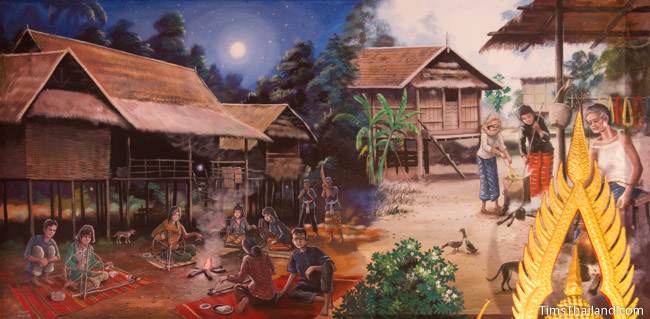
(26) Phuk Siow.
Phuk siow means “friendship bonding” and is for close friends who share similar characteristics or appearance. As part of the formal ceremony, white threads are tied around the wrists of the two friends by a local shaman. Though in modern times it’s a mostly symbolic act, in the past the bonded friends gained a standing equal to siblings in each other’s families. To preserve the tradition, Khon Kaen city has made it an annual event as part of the Khon Kaen Silk Festival.
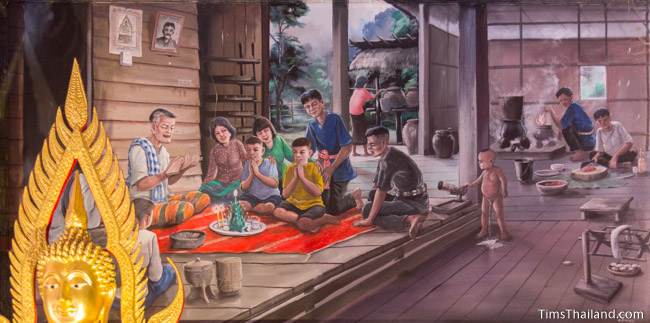
Heet Sip Song – The Twelve Isan Merit-Making Traditions
These twelve merit-making traditions are practiced across Isan and Laos, one in each lunar month. Though many city folk skip several of them, there are very few Isan villages where they don’t all remain important to people’s lives and to community unity. Though most originated from pre-Buddhist beliefs, they’re all Buddhist to some degree now. The months are numbered, but there is no actual first heet: it’s an endless cycle, not a progression. Another article specifically about Heet Sip Song has much more detailed information about each of them.
(27) Boon Khao Kam (Month 1).
During this time, monks who broke certain monastic rules will do penance and spend time in solitude for purification. Lay people take extra food and supplies to the temple at this time to support these monks during their atonement.
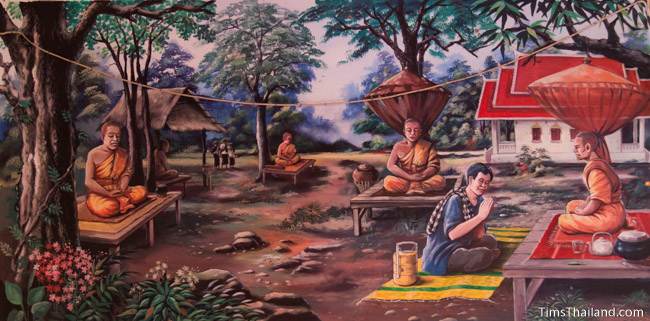
(28) Boon Khun Lan (Month 2).
Boon Khun Lan, one of the most important annual village rituals, is a celebration of the rice harvest and a thank you to all the spirits who helped. A large pile of unhusked rice is blessed and then donated to the monks (see mural #39) and then there are ceremonies to honor the spirits of the village’s rice granaries, paddies, and Mae Phosop, the rice goddess.
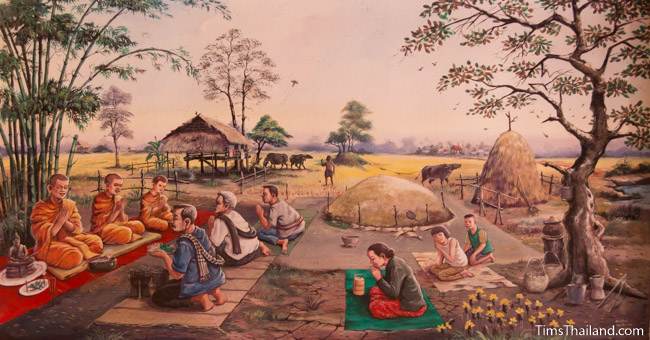
(29) Boon Khao Jee (Month 3).
A common Isan food, khao jee is grilled sticky rice battered with egg. During this celebration, people get up early to grill them for the monks’ morning meal. The tradition stems from a story about the Buddha eating a humble rice cracker given by a very poor woman.
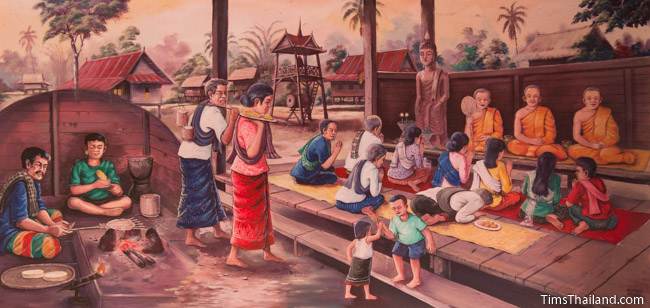
The next seven paintings are inside the corner room.
(30) Boon Pha Wet (Month 4).
In his final earthly life before reaching enlightenment, the Buddha was born as Prince Vessantara (aka “Pha Wet”) and he gave away everything he owned, including his wife and children. Boon Pha Wet is a celebration of his perfect generosity. On the first day, a long scroll with the story painted on it is paraded around and then hung at the temple. The next day people listen to monks read the entire story, which generates considerable merit towards rebirth in the era of Maitreya, the next Buddha.
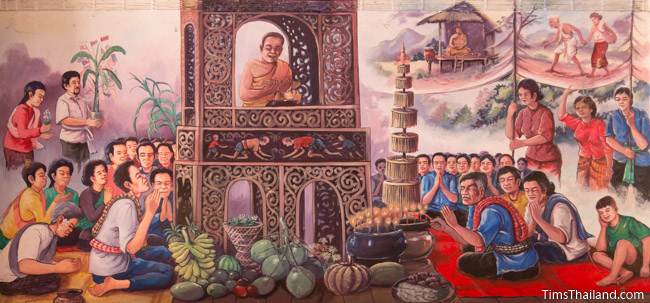
(31) Boon Songkran (Month 5).
Songkran is the Thai New Year, and it’s by far the most important holiday in Thailand. The best known aspect of the celebration is people splashing water on each other, both for fun and to wash away all things negative, which is why it’s often called the “Water Festival” in English. But many solemn activities during Songkran center on paying respect to parents and elders.
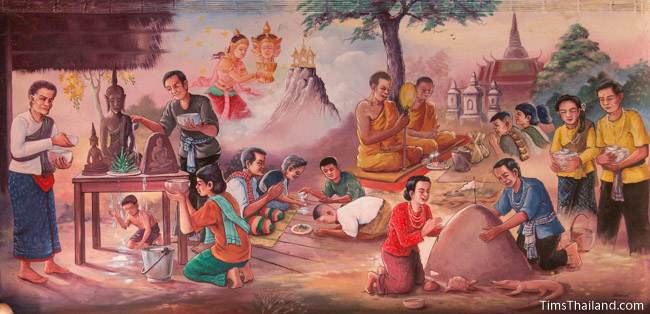
(32) Boon Bang Fai (Month 6).
Known as the Rocket Festival in English, Boon Bang Fai is one of the iconic elements of Isan culture. The festival takes place at the start of the rainy season and the homemade rockets are launched to remind Phaya Taen, the sky god, that it’s time to send the rain. As the rocket festival has its origin in pre-Buddhist fertility rites, there’s a lot of sexual shenanigans like cross-dressing and giant phalluses.
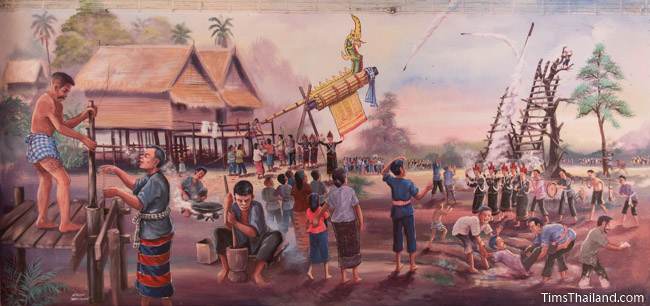
(33) Boon Samha (Month 7).
Samha means “washing,” and this tradition is the Isan version of spring cleaning, on both a physical and a spiritual level. People clean their homes, shrines, and temples and ceremonies are performed to bless the good spirits, including their ancestors, and drive out any bad ones.
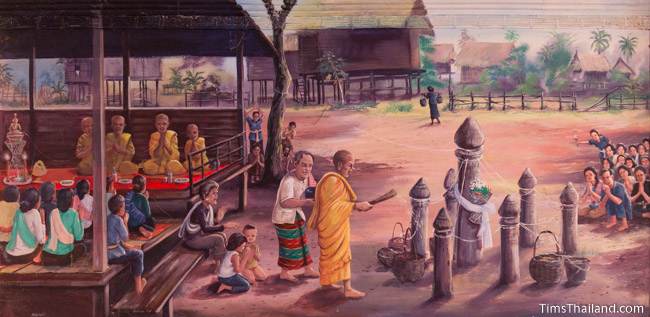
(34) Boon Khao Phansa (Month 8).
Phansa is the three-month Buddhist Rains Retreat, when monks remain at one temple. Many use the time for intense dharma study or meditation practice while lay people are encouraged to be extra devout in following the Buddhist precepts, which is why the Rains Retreat is often called “Buddhist Lent” in English. Khao Phansa is the Rains Retreat’s first day and people bring candles to the temple, and in many places there are candle parades.
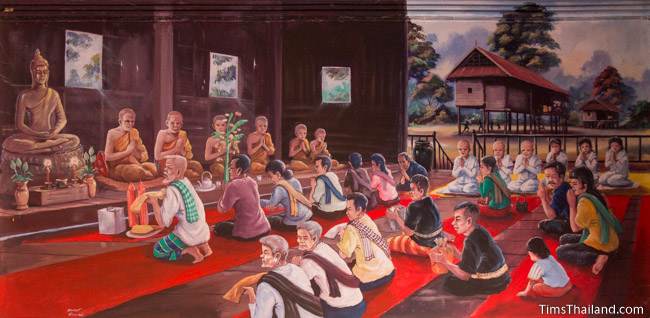
(35) Boon Khao Pradap Din (Month 9).
It is believed that spirits are able to roam to earth at this particular time of year, and Khao Pradap Din is a ceremony to honor one’s visiting ancestors with a feast of food, usually laid out on the ground.
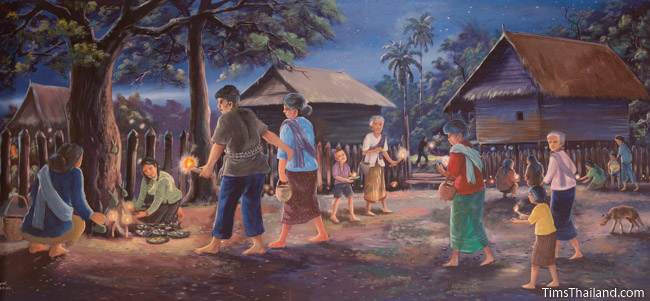
(36) Boon Khao Sak (Month 10).
Boon Khao Sak is the follow-up to Khao Pradap Din from the previous month. It’s the time to say farewell to the ancestor spirits with another feast. As part of the morning donation at the temple, monks draw lots to see whose food trays they get.
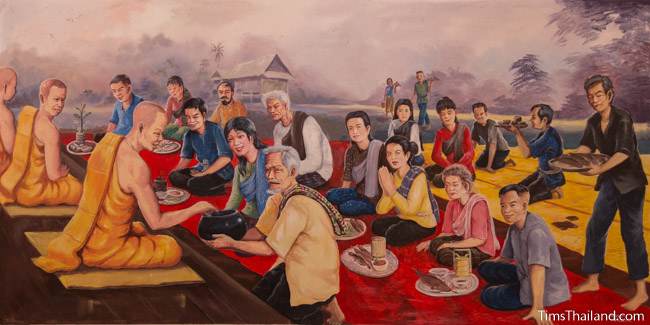
(37) Boon Ok Phansa (Month 11).
Ok Phansa is the end of Buddhist Rains Retreat (see mural #34), aka Buddhist Lent. In the daytime people listen to sermons and watch boat races. In the evening people light candles or oil lamps – these are most impressive along the Mekong and other rivers which display them on large bamboo rafts.
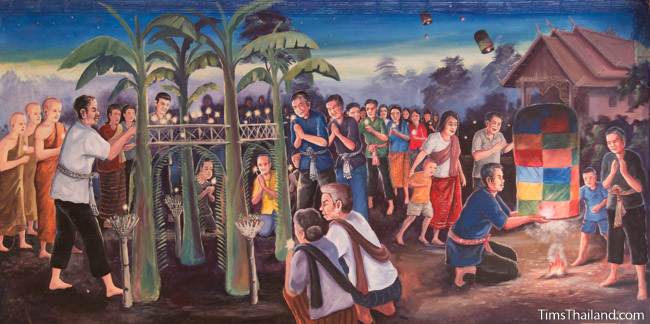
(38) Boon Kathin (Month 12).
Kathin is a ceremony to offer robes to monks and is celebrated nationwide, not just in Isan. Communities lead processions to make the donations at their local temple and when this is done, most towns have other community activities such as boat racing.
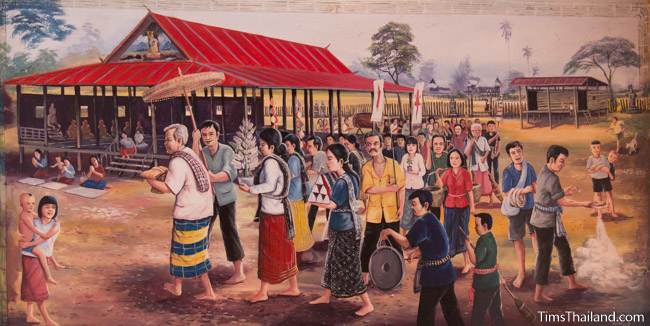
Khong Sip-Si – The Fourteen Isan Social Rules
While the twelve heet (“merit-making traditions”) explained above are annual events, the khong social rules are mostly daily practices. These rules are good for both individuals and entire communities, and all people in the village, regardless of status or rank, follow them together. While the heet remain vital to Isan life, the khong have mostly gone by the wayside. The fourteen rules shown here are for regular people; there’s a different set of fourteen khong for monks and another set of fourteen for kings and important leaders.
(39) The First Khong.
After the harvest season, give the best rice and fruits to the temple before eating or selling any of it. This ensures a good harvest the next year.
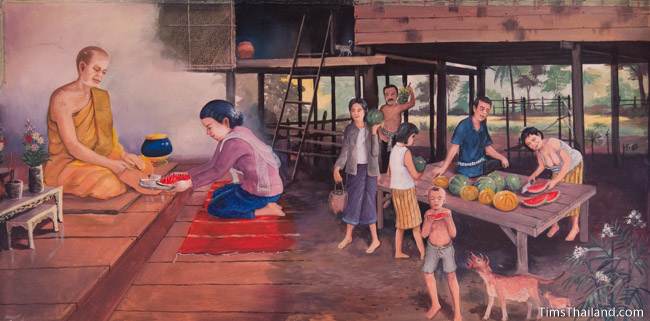
(40) The Second Khong.
Do not gamble, steal, cheat, gossip, or be greedy. This brings you a long, prosperous life.
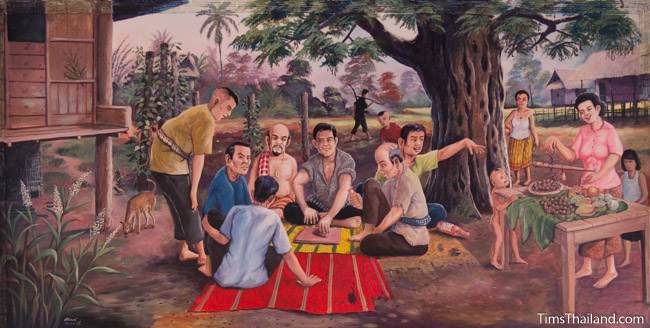
(41) The Third Khong.
Build a fence around your house with a spirit shrine in the corner for good luck and well-being.
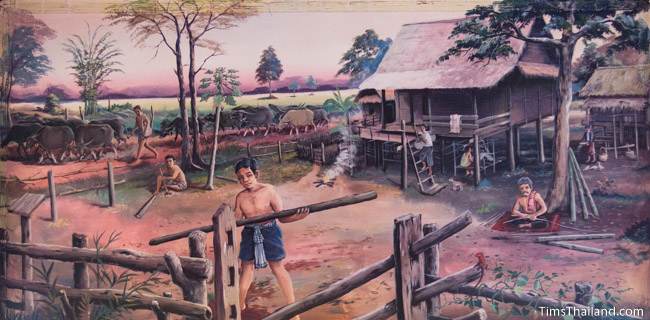
(42) The Fourth Khong.
Keep your house clean by washing your feet before going inside. This keeps dirt out and good luck in.
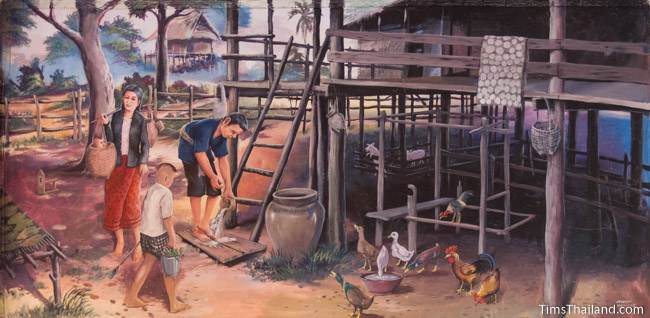
(43) The Fifth Khong.
Pay respect to the spirit of the stairs at your home, which you walk up and down every day, during all Buddhist holidays to ensure prosperity for your family.
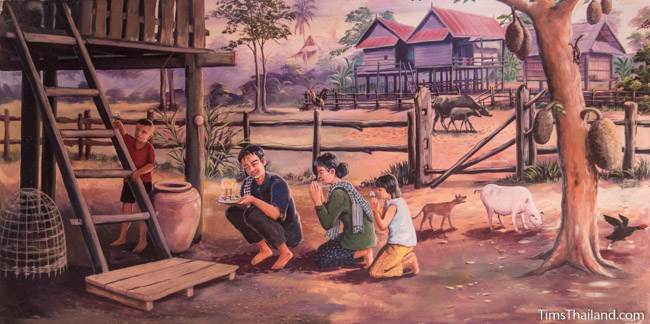
(44) The Sixth Khong.
Wash your feet at night before you sleep so you will wake up happy and lucky.
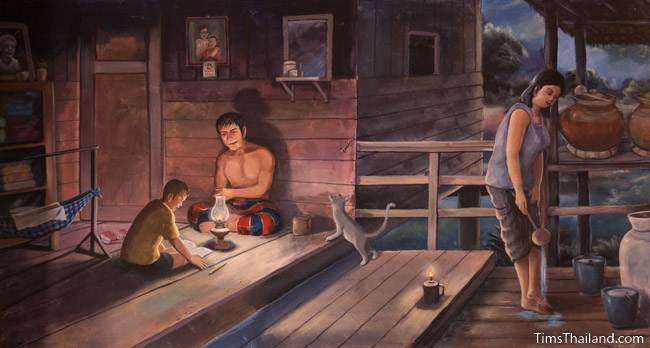
The final eight paintings are inside the storage room.
(45) The Seventh Khong.
On monk days, women should take flowers, candles, and incense to the temple for the monks. Wives should give flowers and candles to their husbands and get a blessing from them. After this, children should give respect to their parents and listen to their advice.
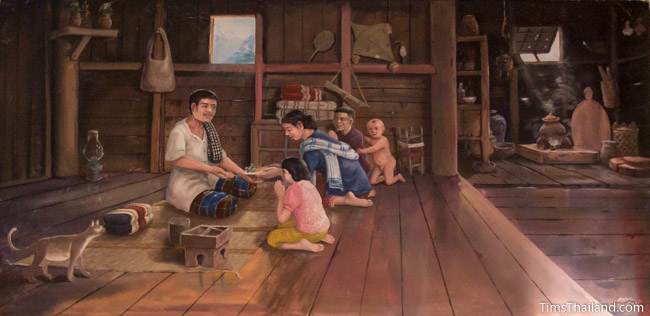
(46) The Eighth Khong.
Invite monks to come pray in your house once a year (either at the full or new moon) to ensure prosperity. This is especially important when moving into a new house.
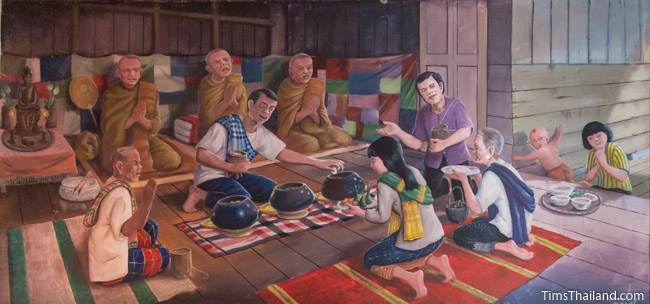
(47) The Ninth Khong.
Wake up early so you are ready to give alms to monks; don’t make them wait for you. Also, don’t wear a hat, carry a baby, or use an umbrella while giving them the food and don’t touch the monks or their bowls.
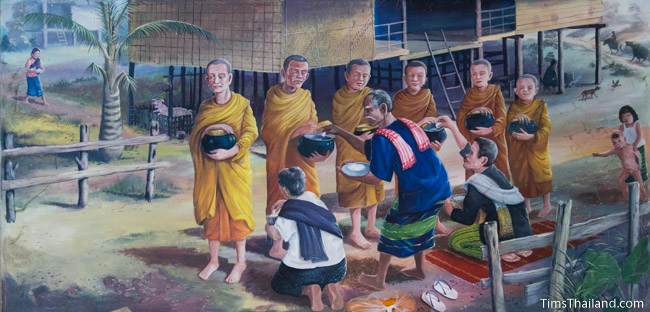
(48) The Tenth Khong.
When monks are doing their pariwatkam penance (see mural #27) they do not go on morning alms rounds, so it is very important to support them by taking food, candles, and other things to the temple.
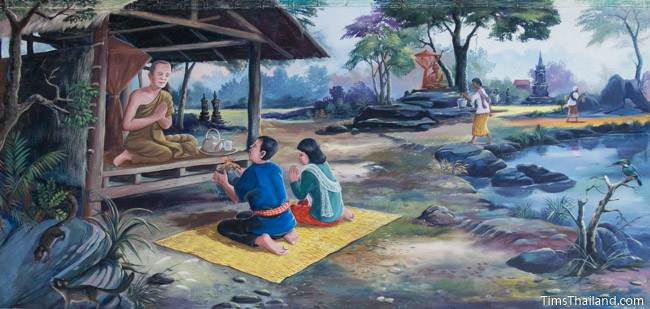
(49) The Eleventh Khong.
Show proper respect to monks by wai-ing and getting on your knees when you talk to them.
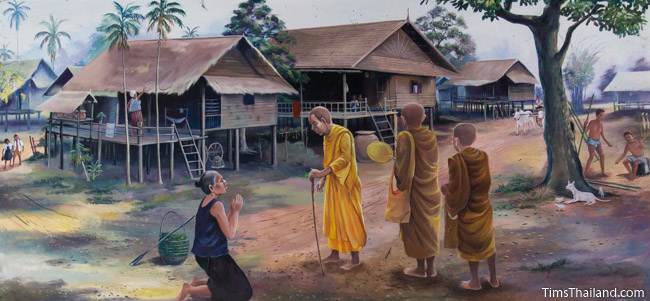
(50) The Twelfth Khong.
Don’t step on the shadows of monks, teachers, or the elderly. This is disrespectful.
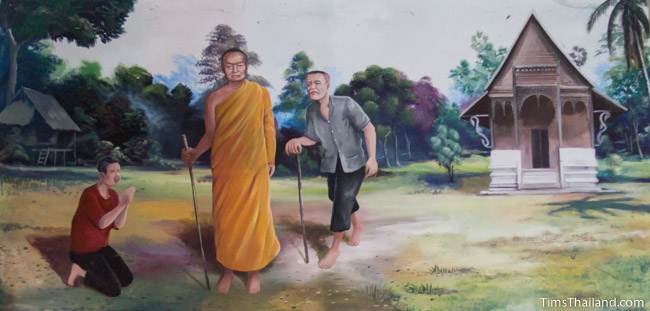
(51) The Thirteenth Khong.
Do not offer leftovers to monks or husbands; always prepare fresh food for them.
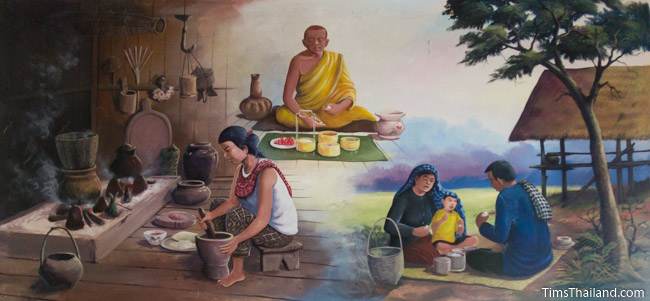
(52) The Fourteenth Khong.
Do not have sex on monk days, Khao Phansa and Ok Phansa (see murals #34 and #37), Songkran (see mural #31), and your birthday.
